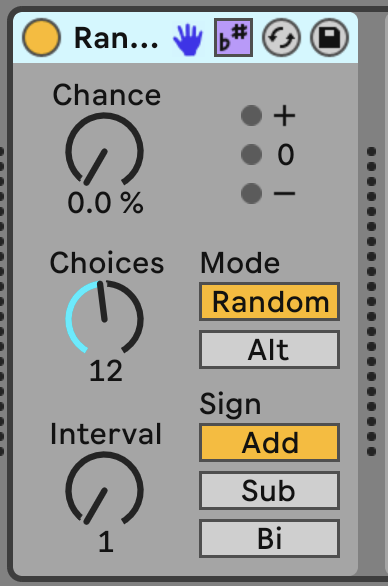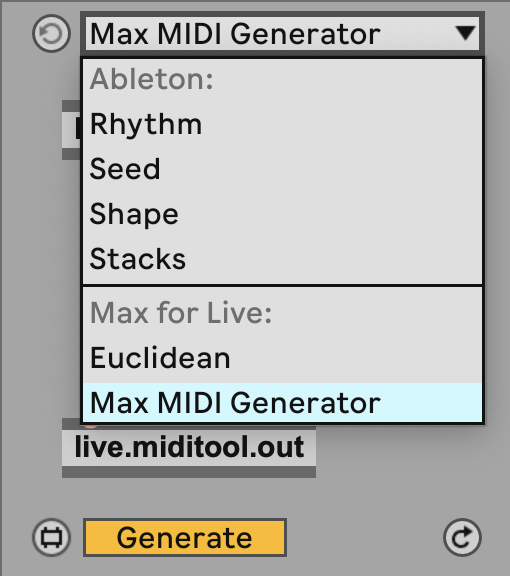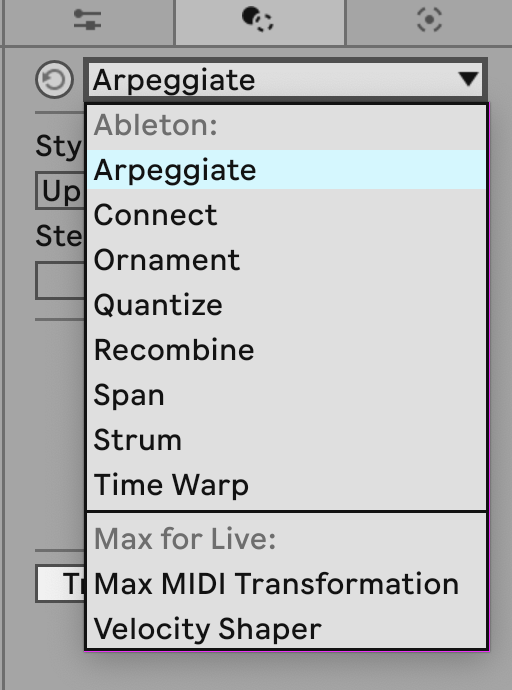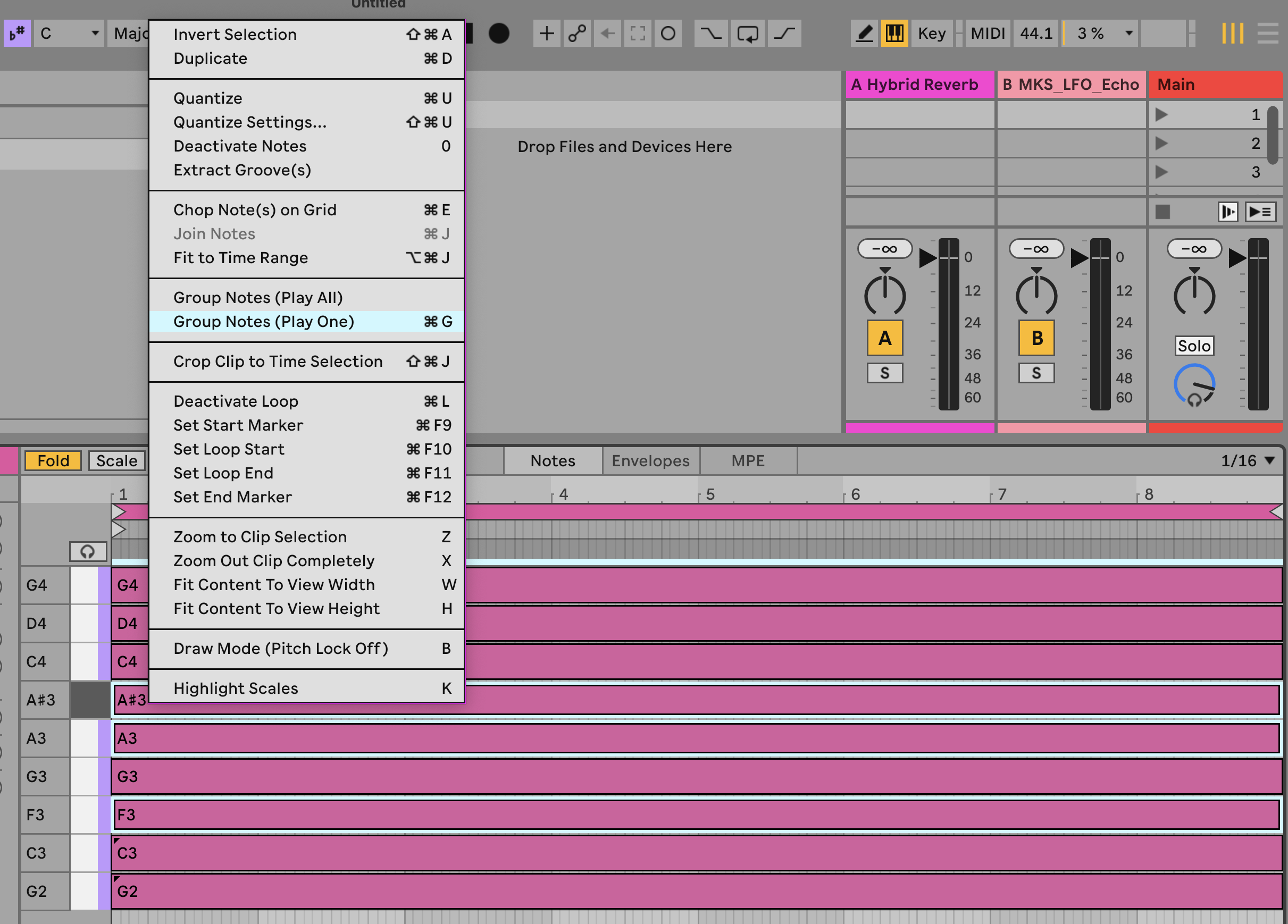
Tools - Live 12 Overview: MIDI and compositional tools
During the process of writing this book, Ableton released Live 12. Live 12 introduced a host of improvements and additions that make life much easier for anyone creating generative music. In this chapter we’ll look at the new compositional and MIDI tools. In the next chapter we’ll look at new sequencer tools. In subsequent chapters we’ll look at updates to modulation, and some specific Transformer and Generator tools.
Live 12 contains a number of tools and new features which enhance how we can make generative music using Ableton Live. Some of these are enhancements to existing functionality, but there are many places where there are brand new features which could be used to create generative music, or provide idea generators for composition.
Scale awareness
Live 12’s scale options let you set any clip to a scale of your choice, and through “Scale Awareness” this scale can be applied to many of Live’s audio and MIDI effects and instruments. This can do clever things like ensuring that Random MIDI effect notes are within scale, that the Resonator resonances conform to the current scale choice, and that harmonic Tone controls in Meld produce harmonics within the chosen scale.
The “Current Scale” is set either when you create a new Live Project, in which case new clips inherit the current scale setting, or the clips in a Scene can define the current scale for that scene. For individual song projects, this works very well. If you’re using multiple scales in a single project (for a live set, for example), it pays to be careful. Ensure that the clips in each scene have the correct scale assigned to them to properly trigger changes to the Current Scale. Proceed with a little caution in live performance is my advice!
The purple b# button means that the Current Scale setting is being honoured by the MIDI effect, audio effect or instrument.
For more on Current Scale settings see https://help.ableton.com/hc/en-us/articles/11425083250972-Keys-and-Scales-in-Live-12-FAQ
In the “Random” MIDI device below, the purple “Scale Mode” or Scale Awareness button is lit, meaning that random pitch shift will be in the context of the Current Scale setting, so shifting up or down scale degrees, rather than semitones. This is a boon for the Lazy Producer because now you won’t need to add MIDI Scale quantizing devices, and also changing the scale in the Current Scale (or through clips), the MIDI devices and instruments will automatically pick up whatever the new Current Scale is.

So now we can chain together MIDI Devices as discussed in Tools - MIDI tools and used in Recipe - Doing more with less using MIDI tools and effects and by turning on Scale Awareness we’ll pick up whatever the Current Scale setting is. Note in the Chord and Arpeggiator devices that instead of “st” semitones for shifting, it is now labelled “sd” scale degrees. This takes a little getting used to because the scale degrees are added onto the MIDI note value - so +4sd is a fifth above the incoming MIDI note.

Scale awareness also extends to some of the Synth instruments in Live 12 - Meld in particular has scale awareness for some of its tone generators, where changing the macro knob for that generator adds harmonic content that is in tune with the Global Scale.
I would continue to use the Scale MIDI Device for live performance just as a fall back to be certain sure that you don’t unexpectedly have one clip that’s playing G minor, while the Current Scale thinks its C major.
Compositional tools
MIDI Generation
Live 12 now comes with two new features built into MIDI clip creation: MIDI Generation and MIDI Transformation. MIDI Generation does what the name suggests - provides a range of different methods for generating new MIDI parts. There are a number of Generation options available covering rhythmic patterns, chords, melodies. We’ll look at some of these in more depth in Tools - Live 12 MIDI Generation and Transformation.
One key point is that these Generator tools are designed for creating new MIDI clips during production, not for “on-the-fly” generation during a performance. Unfortunately at this point they cannot be automated.

MIDI Transformation
The MIDI Transformation tools take an existing MIDI clip or region and perform actions on the MIDI information within that clip. A wide range of useful tools are provided to help permute, rearrange, interpolate and transform (shock!) MIDI. We’ll look at these in more depth in Tools - Live 12 MIDI Generation and Transformation. MIDI transformers should not be seen as “one tool to do everything” - instead you can layer transformations or apply transformations more than once to clips.

Note probability
In Process - Note-wise probability , we looked at Notewise probability - where we can set the probability for each note in a sequence, so we can generate ever changing patterns even from fairly short sequences of MIDI notes. Live 12 has another fantastic feature where we can group notes together and either select to play all notes in the group and adjust the probability of that group of notes, or group notes and select to play only one of the notes in that group. What this means for the Lazy Producer is that you can specify chords that when triggered play all of the notes (probability acts on the chord) or you can nominate a group of notes where the computer picks which note in the group will play, but you can ensure that exactly one of those notes will be played.

Let’s give a concrete example. Imagine you want to set up an arpeggiated pattern, but you always want the pattern to play four notes. You always want the root note of chord and the fifth of the scale to play, but you want the other two notes in the pattern to vary each time the chord is played. Well you would group the root and fifth and select “Play All”, while you could group the other notes in the chord and select “Play One”. This will maintain a steady pattern and predictable notes (root and fifth of the scale) while other notes provide some randomness and interest. Note that these actions on the grouped notes (Play One, Play All) also follow whatever is set for the probability setting for those notes / groups. So you can have a group of notes with “Play One” but that one note will only happen 50% of the time. This opens up enormous flexibility in generating note patterns or sequences with a LOT of variation.